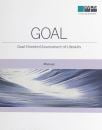
Goal-Oriented Assessment of Lifeskills goal
For: An evaluation of functional motor skills in activities of daily living in individuals aged 7 to 17 years
Format: Individual administration of 7 activities
Length: Admin Time 45-60 minutes
Scoring: Hand Scored
Printed Kits
Click to browse products
Printed Forms & Handscoring Materials
Test forms, response booklets and scoring reference manuals.
GOAL Kit
GOAL Paper Box Sheet (25)
GOAL Record Form (25)
Author
Lucy Jane Miller, Ph.D, OTR; Thomas Oakland, Ph.D, and David S. Herzberg, Ph.D
Description
The Goal-Oriented Assessment of Lifeskills (GOAL) is an innovative new evaluation of functional motor abilities needed for daily living. Designed for children aged between 7 to 17 years, the GOAL consists of seven Activities, fun and motivating tasks based on real occupations of a child’s daily life. Each Activity is linked to Intervention Targets that help you turn assessment results into a specific, goal-oriented treatment plan. This standardised, psychometrically precise instrument offers an ecologically valid description of a child’s competencies and opportunities for growth in both fine and gross motor domains.
The GOAL may help determine eligibility for special services and inform planning of occupational and/or physical therapy and adaptive physical education. It’s useful in a variety of settings, including schools, clinics, hospitals, and private practice. Although intended primarily for occupational therapists, it may be used by other professionals, including psychologists, physical therapists, and other childhood intervention specialists.
Administration, Scoring, and Applying Results to Treatment
In this individually administered assessment, the child performs seven Activities representing a range of functional tasks. Dr. A. Jean Ayres’ sensory integration theory describes many of the key concepts underlying the GOAL Activities. This theory proposes that processing of sensory inputs provides a foundation for development of cognitive and motor skills.
Activities
– Fine Motor:
Utensils: Using a knife, fork, and spoon to cut, spear and scoop
Locks: Opening keyed and combination padlocks
Paper Box: Colouring, cutting, folding, and taping a paper construction project
Notebook: Organising and filling a three-ring binder
– Gross Motor:
Clothes: Putting on and taking off a T-shirt and shorts
Ball Play: Bouncing and kicking a ball
Tray Carry: Carrying a loaded tray and avoiding obstacles
The innovative Record Form follows the natural workflow of an assessment: from recording the child’s performance, through to calculating and interpreting scores, to developing a treatment plan. The centre panel of the form, the Progress Chart, allows you to graph the child’s overall functional ability and identify specific targets for intervention. On the right panel of the form are the Intervention Targets, which allow the examiner to link the child’s performance to specific intervention objectives. There are four columns on this panel-Sensory, Postural, Praxis, and Motor Proficiency-showing the Intervention Targets associated with each Activity. Each row of the Record Form has a set of Intervention Targets associated with the underlying component skills needed for that specific Functional task.
The GOAL scores are based on 54 Steps-small units of easily observable, functional behaviour within the seven Activities. These are scored based on three elements of successful functional performance: accuracy, independence, and speed. Using the Record Form, each Step is scored pass or fail; then the Step scores are summed to yield the Fine Motor and Gross Motor Standard Scores, as well as the Progress Score.
The Standard Scores enable you to compare the child you are testing to peers of the same age and gender, and may help to determine eligibility for therapeutic services and placement in special education programs. The Progress Score is a single index of the child’s overall ability to perform functional tasks, and may be used to track improvement over time.
Standardisation and Psychometric Properties
The GOAL Activities were standardised on a sample of 616 children aged between 7 to 17 years, drawn from all four geographic regions of the United States. A clinical sample of 152 children referred to occupational therapy for mild to moderate sensory and/or motor challenges were also collected. Statistical analysis of the GOAL demonstrates good reliability and validity. In addition, it also provides clear evidence that it is a useful tool for distinguishing typically developing children from clinic-referred children, including those with sensory and motor disorders, autism spectrum disorders, ADHD, and learning disabilities.
Reliability
Analysis of the standardisation sample shows acceptable internal consistency correlations for both the Fine and Gross Motor Standard Scores (all >.75). These are consistently higher in the clinical sample (>.84), which represents the target population for the GOAL Activities. Internal reliability for the Progress Score is .90. Test–retest reliability data for the clinical sample demonstrate acceptable correlations of .76 for the Fine Motor Standard Score and .77 for the Gross Motor Standard Score.
Validity
Convergent validity data was collected for four assessments: the Sensory Integration and Praxis Tests (SIPT), the Sensory Processing Measure (SPM), the Bruininks-Oseretsky Test of Motor Proficiency, Second Edition (BOT-2), and the Adaptive Behavior Assessment System, Second Edition (ABAS-II). Scores generally correlate in expected ways with these measures, showing acceptable evidence of construct validity.
Reliably Distinguishing Typically Developing Children From Clinic-Referred Children
The differences in mean standard scores between the standardisation and clinical samples represent large, clinically significant effect sizes. Analysis from the samples demonstrate good sensitivity and specificity:
74% of the clinical sample had Fine Motor Standard Scores of 85 or less
85% of the standardisation sample had Fine Motor Standard Scores of 86 or more
79% of the clinical sample had Gross Motor Scores at or below 85
87% of the standardisation sample had Gross Motor Scores at or above 85
More information about the psychometric characteristics of the GOAL is included in Chapter 6 of the Manual.
Related Products
NB: Prices are in Australian dollars inclusive of GST. NZ customers need to log in to view ex-GST prices.



